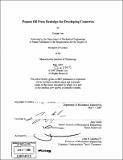Peanut oil press redesign for Developing countries
Author(s)
Lee, Daipan
DownloadFull printable version (1.887Mb)
Other Contributors
Massachusetts Institute of Technology. Dept. of Mechanical Engineering.
Advisor
Amy Smith.
Terms of use
Metadata
Show full item recordAbstract
One of the causes of malnutrition among the rural inhabitants of Sub-Saharan Africa is the high cost of dietary fats that are necessary to maintain normal body functions. Though the Food and Agriculture Organization of the UN recommends an annual intake of 9.6 liters of dietary fats a year per person, some areas of Africa consume only about 1.5 liters annually. Many members of these communities lack the resources to purchase imported edible oils; locally produced peanut oil would provide a cheaper alternative. In addition, peanut production is particularly beneficial to farmers, as peanut plants enrich the soil they grow in. Once they have a steady supply of peanuts, the problem facing farmers is the inability to efficiently extract the oil from the nuts. The current design for human-powered rapid extraction is the Bielenberg ram press, which uses a lever to generate the required pressure needed to extract the oil. However, this design is not optimal for two reasons: it requires significant upper body strength to operate, and also, incorrect operation of the lever leads to only a fraction of the peanuts' oil content being extracted. For these reasons, this thesis focuses on a design modification originally proposed by a team in D-Lab Spring 2006. (cont.) While the oil extracting mechanism was kept intact, the lever was replaced by a cam-and-follower system driven by treadles. By moving the driving motion from the upper body to the lower body of the user, the new design aims to address the ergonomics issue present in the Bielenberg ram press. The cam also allows optimization of the pressure profile for the peanuts. Research performed by Ravi Patel in 2007 has shown that a rapid buildup followed by a long period of followed by a gradual advancing of the piston will create the desired pressure characteristics to maximize output. An earlier attempt to convert the Bielenberg ram press into a treadle design yielded several insights into how the design could be improved. These insights have led to many design modifications, which are incorporated into the proposed redesign. This redesign is aimed at improving performance, reducing cost, and increasing the manufacturability of the press.
Description
Thesis (S.B.)--Massachusetts Institute of Technology, Dept. of Mechanical Engineering, 2007. Includes bibliographical references (p. 28-29).
Date issued
2007Department
Massachusetts Institute of Technology. Department of Mechanical EngineeringPublisher
Massachusetts Institute of Technology
Keywords
Mechanical Engineering.